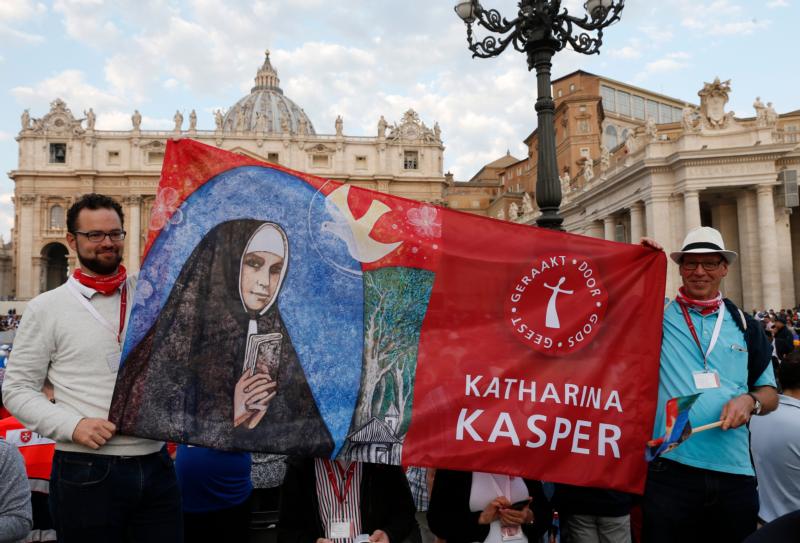
Men hold a banner showing new St. Catherine Kasper before the canonization Mass for seven new saints celebrated by Pope Francis in St. Peter’s Square at the Vatican Oct. 14. Among those canonized were St. Paul VI and St. Oscar Romero. (CNS photo/Paul Haring)
VATICAN CITY (CNS) — As the sun rose over the Tiber River, seven banners hanging on the facade of St. Peter’s Basilica depicting the church’s newest saints were illuminated by the new day.
Pilgrims from all over the world had lined up behind metal barricades on the outer perimeter of the square until members of the Swiss Guard, security officers, police at metal detectors and volunteers wearing blue bibs got into position and ready for the tens of thousands of people attending the canonization ceremony and Mass Oct. 14.
“Good morning, Brescia!” shouted one volunteer steering a large group from the Italian province, where St. Paul VI was born, through the maze of barricades to get into the square. Many pilgrims were easy to identify with colorful banners, flags, hats or bandanas emblazoned with their saint’s image or name.
[hotblock
In the crowd was Maria Giovanna Cimoli from Concesio, the small hometown of St. Paul VI. “I am so excited, so proud to be here. We live on the same street (St. Paul VI) lived on growing up,” she told Catholic News Service.
“I was living here in Rome when he was elected,” she said. “I was in the square when they said his name. It was a shock.”
Forty-two years after they were married, Lucia Bescotti and Giovanni Ballini from Brescia found themselves once again waiting in line to get into St. Peter’s Square.
St. Paul VI had greeted them and given them his blessing in Rome after they were married in 1976 “when we were young,” Bescotti said.
One U.S. mom, Jessica McAfee, 33, said a group of nuns formed an impromptu protective shield around her, her husband, Shaun, and their three small kids so they wouldn’t get lost or bumped into. Their fourth child, a three-month old girl, was safely strapped to her mom’s chest in a baby carrier.
The McAfees, who live in Omaha, Nebraska, but are based temporarily in Vicenza, Italy, were at the ceremony for St. Paul VI, whom she credits with her conversion to Catholicism.
Her husband wanted to be a Catholic, she said, and she was attending the RCIA classes with him “just supporting him” on his journey. But after her risk of miscarriage brought her to medical professionals and the Pope Paul VI Institute, she was struck by the beauty of the icons at the facility and the loving care of the doctors.
“They opened the doors for me. They met me where I was at and gave dignity to our unborn baby,” which was something that she had not encountered with other doctors, she said.
Now a FertilityCare practitioner at the institute, McAfee said she thinks the pope’s 1968 encyclical “Humanae Vitae” on human life and married love has much to offer people today.
Andrew Pandorf and Louisa and Sandra Schlemmer were in Rome from the small German town St. Catherine Kasper was from; the new saint worked with the poor and needy and founded a religious order in the 19th century.
[tower]
“My grandfather was a big fan” of St. Catherine, Louisa said, and he claimed to have had a vision of her while in the hospital near death. The now-saint told him to get water from a particular fountain and when his wife did so, “he was cured,” the granddaughter said.
“It was his big wish to be here, but he died this January so it’s important for us to be here for him,” she added.
A group of seminarians from the Alessio Ascalesi archdiocesan seminary in Naples left at 3 a.m. to get to Rome for the canonizations of St. Vincenzo Romano, an Italian priest born in Naples in 1751, and Nunzio Sulprizio, a layman who died in Naples in 1836 at the age of 19.
“We chose Vincenzo Romano to accompany us on our journey to be saints in little things,” a seminarian named Francesco said; “and we chose Nunzio, because he wanted to be a priest but couldn’t, so we look to him to see what pushes us to want to be a priest.”
About 20 seminarians from the Diocese of Cremona were there for St. Francesco Spinelli, a 19th-century priest who founded and set up in Cremona the religious order, the Sisters Adorers of the Blessed Sacrament.
Guglielmo Tarcisio Paluschi, 24, a seminarian in his fourth year of studies said St. Spinelli was “a great example for the priesthood.”
“He understood the heart of Christian life is the Eucharist, where a Christian finds the strength to go out and bring to others what he has received,” he said.
Paluschi said their group had a private audience Oct. 13 with Pope Francis, who urged them to try to make the Gospel understandable to young people because they are receptive.
“He did it,” Paluschi said pointing to St. Spinelli’s banner on the basilica’s facade. “During his era, he found a way to make others understand Christ lives in each person” and is present in the Eucharist.
When asked what attracted him to pursue the priesthood, he said he has met many good priests who have “shown it is possible to be happy, to find happiness in the priesthood.”
Reflecting on his life, he said he sees Jesus “is calling everyone to a vocation of happiness and, in happiness, people can become a saint. If you look at your life, you can see lots of people leaving you ‘seeds’ that grow, and if you keep following, they lead to holiness,” he said.
“He succeeded,” he said, looking again to the banner, “He became a saint.”
PREVIOUS: Saints risk all for love of Jesus, pope says at canonization Mass
NEXT: For Catholics, St. Oscar Romero’s canonization a dream come true



Share this story